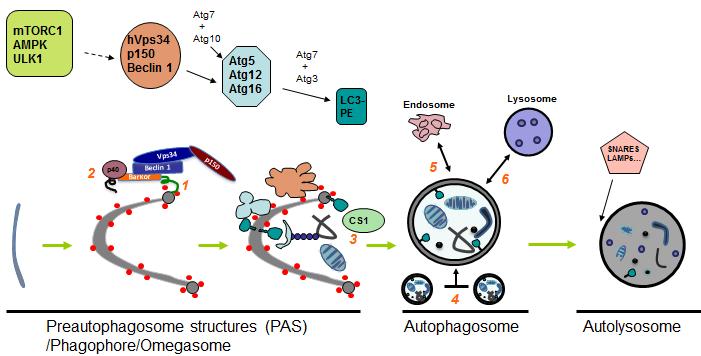Project 1: Mechanism of autophagy
Mechanism of autophagosome biogenesis: During autophagy, a double membrane
autophagosome engulfs cargo such as damaged organelles, cytosol, and
microorganisms and then fuses with lysosome where its internal components
are degraded by acid hydrolases. The formation of autophagosome is driven
by the combined effort of lipids and proteins. Phosphatidylinositol
3-phosphate (PtdIns(3)P) has been shown to be extremely important for
autophagosome biogenesis. PtdIns(3)P production is characterized by the
class III phosphatidylinositol 3-kinase (PI3KC3) that is evolutionary
conserved from yeast to humans. We are the first group to purify and
identify the human PI3KC3 complex, which contains seven components hVps34,
p150/Vps30, Beclin 1/Atg6, UVRAG, Rubicon, Barkor/Atg14(L), and p40. Three
of them, Barkor, Rubicon and p40, have not been previously linked to
autophagy. Seven subunits form two mutually exclusive subcomplexes that
are targeted to either autophagosome or endosome. We report that the
Beclin 1-hVps34-p150 complex are targeted to autophagosome by
Barkor/Atg14(L). Barkor positively regulates the PI3KC3 activity on the
autophagosome membrane, through which it determines the specificity of
PI3KC3 in the autophagic pathway. Moreover, we found that Barkor interacts
with the autophagic membrane through its C-terminal 80 amino acids (named
the BATS domain), and senses membrane curvature via an ALPS motif within
the BATS domain. Hence, we propose that Barkor plays a dual role in
autophagosome biogenesis by activating PI3KC3 on membrane and facilitating
membrane curvature development, which are crucial for autophagosome
biogenesis. The function of p40 is under investigation now. In the future
study, we will focus on dissecting the signaling pathway regulating the
PI3KC3 complex in autophgay, and we also aim to reconstitute the PI3KC3
lipid kinase activity and membrane deformation activity in vitro.
Selective degradation by autophagy: Autophagy degradation could be both
non-selective and selective. We aim to identify selective autophagic
substrates and cargo adaptors. For this purpose, we purified the cellular
complex of LC3. In addition to p62 and FYCO-1, two well-known adaptors, we
have also identified Keap1. Keap1 is crucial for oxidative stress
response. Keap1 is a cargo adaptor but not likely a substrate. Keap1
interacts with p62 and LC3 and colocalizes with ubiquitin aggregates in a
stress-inducible manner. Genetic ablation of Keap1 leads to the
accumulation of ubiquitin aggregates, increased cytotoxicity of misfolded
protein aggregates, and defective activation of autophagy. More
interestingly, in the LC3 complex, in addition to p62, Keap1 and FYCO-1,
we have also identified another set of interacting proteins, the
biological significance of these interaction proteins are being studied in
the lab.
Autophagosome maturation by the endosomal PI3KC3 complex: The
endosome-localized PI3KC3 subcomplex is important for autophagosome and
endosome maturation. We found that two newly identified PI3KC3 subunits,
Rubicon and UVRAG, are both localized to early endosomes. Rubicon
functions as a negative regulator since it antagonizes UVRAG by
sequestering it in the complex form. Interestingly, this sequestration is
released by Rab7. GTP-bound Rab7 preferentially interacts with Rubicon and
frees UVRAG. In addition, our mapping analysis reveals that different
regions of Rubicon, mediating the interaction with hVps34 and Rab7
respectively, contribute to autophagy and endocytosis differentially.

Project 2: Function of Mule in DNA damage and HDACi induced apoptosis
Apoptosis-inducing DNA damaging agents has been widely used as anti-cancer
reagents. New emerging next-generation cancer drugs like histone
deacetylase inhibitors (HDACi) also elicit apoptosis. The apoptotic
mechanisms underlying these drugs are not well understood. My lab is
working on one such critical mediator Mule in these drugs induced
apoptosis. Mule is named as Mcl-1 ubiquitin ligase E3. Mule also targets
multiple substrates in the DNA damage response. In this study, we
generated and characterized Mule knockout MEFs through collaboration with
Dr. Zhenyue Hao and Dr. Tak W Mak at University of Toronto. We found that
Mule is crucial for DNA damage and HDACi induced apoptosis, which is due
to the elevated HDAC2 activity in Mule null cells. Mule specifically
targets HDAC2 for ubiquitination and degradation. The accumulation of
HDAC2 in Mule null cells leads to severe defects in p53 acetylation,
phosphorylation, accumulation, transcriptional activation and apoptosis
upon stress. These phenotypes could be partially reversed by
administration of HDACi, and fully rescued by lowering elevated HDAC2
protein levels in Mule null cells. This study identifies the Mule-HDAC2
pathway as key mediators in the apoptotic response to HDACi and DNA
damage, and this knowledge might be important for the HDACi application in
cancer treatment.
The molecular mechanism underlying the crosstalk among apoptosis,
autophagy and necrosis are also being extensively studied in the lab.



